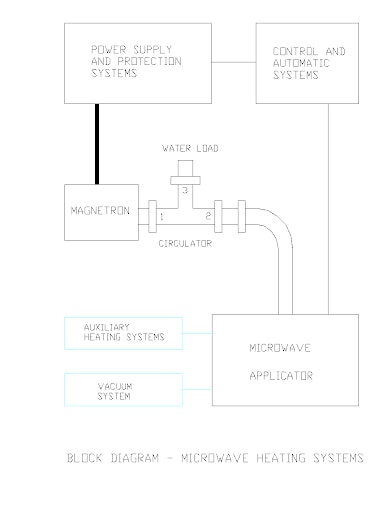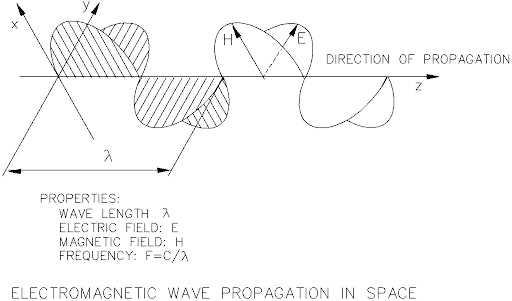Understanding Microwave Heating Systems: The Nature of Efficient Technology
Thermex-Thermatron Systems
When implementing microwave (MW) heating technology on the production floor, proper operation, parameter settings, and procedures deliver the optimum treatment of process materials. With a clear command of microwave heating systems, applicable knowledge is a cornerstone to yielding strong materials; a crucial advantage in microwave processing — from the formulation of the process material itself to the configuration material processing using MW equipment, whether for conveying, positioning, or containment.
Additionally, the measured dielectric properties of materials can serve as invaluable research tools. Moreover, the dielectric properties of materials in drying or curing operations can demonstrate a measure of how far along the drying or curing has progressed. To analyze the interactions of matter and fields, first, we must consider the nature of fields themselves — examining the mechanisms by which fields are absorbed and converted into heat, heating rate formulas, as well as the analysis of key technical terms. Then, we can explore crucial chemical and geometric parameters.
Drawing on a leading background in dielectric heating, Thermex-Thermatron Systems (“Thermex”) has advanced the development of labor-saving radio frequency (RF) and microwave equipment since 1939. Today, applying over eight decades of innovation, Thermex has pioneered critical RF, MW, and industrial technology, helping industries around the world boost productivity clear of emissions. Offering a deep dive into microwave heating system technology and building robust systems that utilize highly engineered designs, Thermex’s premier insights and techniques give manufacturers the cutting-edge resources to drive key production processes forward. Understanding microwave heating systems will allow industries to safely achieve precision — with the necessary speed to satisfy escalating demands.
Microwave Heating Theory
Assessing the interactions of matter and high frequency electromagnetic fields, knowledge of pivotal dielectric properties and their structure at the molecular level is important. For instance, the rate of change of dielectric properties with temperature equals a measure of the activation energy of intermolecular displacements, rotations, bending, and twisting. Then, just as inline infrared monitoring of the process material can be used for automatic temperature control, inline microwave monitoring has potential for automatic control of moisture level or polymerization.

The Power of Magnetrons
Most industrial microwave heating systems use magnetrons to generate a large amount of microwave energy. The system contains the following:
- The Microwave Generator or Microwave Power Unit
- The Microwave Applicator (Oven, Waveguides, Special Applicator, etc.)
- The Auxiliary Systems (Conveyor, Hot Air Generator, Air Circulation, Steam Generator, Exhaust System, etc.)
The Microwave Generator primarily consists of a high voltage power supply, the magnetron circuit, control and protective circuit, cooling system, and circulator with water load. When it comes to the size or shape of the MW applicator, this will vary based on the type of process performed with the system. That said, continuous conveyorized ovens tend to take precedence as the most common types of applicators.
Auxiliary systems generally consist of five integral pieces:
- The Material Handling Unit (conveyor, turntable)
- Hot Air Generator
- Air Circulation
- Steam Generator
- Exhaust System (if applicable)
The following diagram illustrates the typical components that empower a high-powered Microwave Heating system:

The Nature of Microwaves
As a kind of radio wave, microwaves are part of a class that also contains visible light — representing only a small part of the electromagnetic spectrum (illustrated below). As such, microwaves exhibit wave properties, which enable them to be generated, sent through space, and received or absorbed at a distance.
Sometimes, that space may be empty; from vacuum and air-filled to those filled with certain liquids or solids. Also called microwave insulators, some liquids or solids, analogous with visible light, are transparent to microwaves. Consider that most materials hold some degree of absorption, much like haze or smoke when it comes to visible light. As a result, when microwaves make passage through the materials, this uses up a significant fraction of the microwave energy; subsequently heating the material through which the microwaves travel.

High frequency heating applications for industrial purposes represent only a small part of the electromagnetic spectrum, as shown above. Implemented in key functions, high frequencies empower various fields from broadcasting and communications to navigation and satellite tracking. Additionally, certain frequencies have been allocated over the years for industrial, scientific, and medical use (ISM bands). With radio frequency, commonly used ISM bands are 13.56 MHz and 27.12 MHz; while those for microwaves are 915 MHz and 2450 MHz.
As illustrated in the diagram below, microwave energy is composed of two predominant fields: electric and magnetic. Notably, electric and magnetic fields are complementary to one another; much like the colors blue and orange. There are applications that can be achieved with one color to obtain the other. Similar to the sine and cosine functions, which are derivatives of one another, electric and magnetic fields harness a pivotal property; where each becomes the combined time and space derivative of the other. Essentially, if you have one and change its strength in time and space, you are then able to automatically produce the other.

Next, consider the ultimate field every member of society has witnessed in plain sight: the wind. After all, the simple flow of the air holds all the properties that we can use to better understand electric and magnetic fields. Though invisible, the wind has direction; for example, east-southeast. It has strength; sometimes a gust hits at 20 miles per hour. Lastly, it has energy; the very energy that powers sailboats, windmills, or can unleash the megatron rating of a hurricane.
Capable of transporting loose objects from dust to seeds, the wind can rotate and line up tied-down objects across fields of grass, windsocks, and weathervanes. Its flow alternates from steady to storm forces of turbulence. When the gusts come close enough together, our ears can hear them, registering waves as sound. Consider concepts of sound, which can shift from bass, baritone, and tenor to alto or soprano. As electromagnetic analogs, these exemplify the concepts of everything from radio frequency and microwaves to infrared, visible light, and ultraviolet.
Applying this analogy to microwaves, think of the wind instead as an electric field; east-southeast direction as up, down, left, or right; miles per hour as volts per inch; dust and seeds as electrons or ions; windsocks and weathervanes as molecular dipoles; gusts per minute as gigahertz; and horsepower as kilowatts. The controlled useful application of airflow is the art of ventilation and air conditioning, which calls for a lot of air ducts; the very air ducts we use in microwave applications (called waveguides).

By definition, stationary charges produce the electric field, whereas moving electric charges produce the magnetic field. Here, a time-changing magnetic field produces an electric field and vice versa. The theoretical representation of the electric and magnetic fields is given by Maxwell’s equations; and the solutions to these equations are electromagnetic waves, where the electric and magnetic fields both travel together through space at the speed of light. Electric and magnetic fields remain at a 90° angle to each other at all times throughout this process.
Conceptualizing and examining microwaves composed of fields, we wouldn’t necessarily think of the fields as building blocks, creating microwaves. Rather, we should think of these fields as what microwaves really are. Whenever assessing the properties of microwaves, we are really talking about the properties of the fields themselves.
Optimizing Drying and Curing Processes with the Command of Enhanced Capabilities
Leveraging these theories assists production facilities in properly operating industrial microwave equipment — setting the operating parameters toward the achievement of desired treatment of process materials. This knowledge can be critical in formulating materials used throughout microwave processing. From the formulation of the process material itself to the configuration material processing, a clear grasp of the nature of technology will allow you to use microwave equipment strategically; such as for conveying, positioning, or containment.
With the insights, expertise, and powerful tools to tailor versatile solutions, Thermex offers a fully dedicated in-house laboratory, ThermaLab, where you can test these conceptualizations in motion. Test out a variety of machine types utilized to elevate microwave processes and select the most suitable system for your production needs. With the support of our skilled engineers, guiding you through each step of the process, uplevel your productivity as well as facility-wide processes; applying the advantages of quality, proven technology.
For Thermex and Thermatron inquiries, contact our Director of Sales, Dean Mancuso (Sales@thermex-thermatron.com; 502/916-8972 or 502/243-5636).
For FIAB and Oteman inquiries, contact our Director of Business Development, Traci Evling (Traci@thermex-thermatron.com; 502/916-8981 or 904/662-2169).

